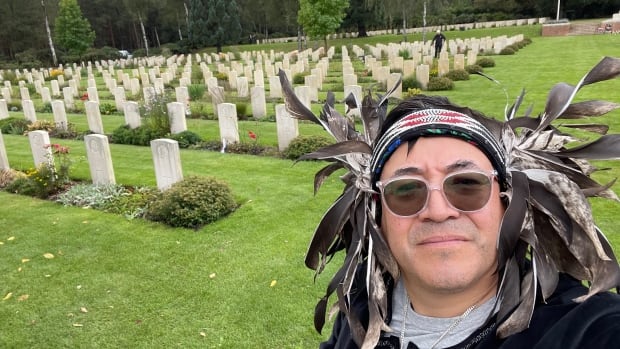Squamish Nation councillor travels to Netherlands to honour grave of long-lost relative
For almost 80 years, the remains of Private Daniel Cheer laid in an unmarked grave in the Holten cemetery near the Netherlands’ border with Germany.
It wasn’t until earlier this year that his grave was identified as part of the Indigenous Legacy Project, a joint initiative between the Royal Canadian Legion and Aboriginal Veterans Autochtones. Cheer’s was one of 17 Indigenous graves identified at the cemetery.
Squamish Nation councillor Sxwíxwtn, Wilson Williams, was part of a small delegation that recently returned from visiting the graves.
“It was quite an emotional time,” Williams told The Early Edition host Stephen Quinn of the visit.
“No one had visited him since he passed away.”
While he was there, Williams laid down some flowers and tobacco. He says he also shared a prayer, a song and some stories about the Squamish people today.
“I just feel, in my heart, it’s time to share his story,” he said.
Recognizing sacrifice
In a written statement, Martin Reelick, president of Netherlands-based Royal Canadian Legion Branch 005, said 81 Indigenous soldiers have been identified all over Holland so far.
“It’s a privilege to welcome some of their descendants to our country as we recognize and commemorate their many sacrifices,” Reelick said.
Cheer grew up in Brackendale, B.C. — about 54 kilometres north of Vancouver — and was a member of the Squamish First Nation. According to Veterans Affairs Canada, he was one of more than 3,000 First Nations people who served in the Second World War. More than 200 of them died.
A member of the Seaforth Highlanders of Canada, Cheer was 24 when he was killed in action in 1945. He lies alongside the remains of more than 1,300 Canadian soldiers at the cemetery.
Roughly 175,000 Canadian soldiers helped liberate the Dutch from the Nazis. More than 7,600 of them died during that eight-month campaign, one of Canada’s last major contributions in the Second World War.
‘Overcoming significant discrimination’
Cheer was 18 when he volunteered to fight. At the time, Indigenous people in Canada weren’t recognized as citizens and didn’t have the right to vote. The residential school system was still in full force.
In a written statement, Ginette Petitpas Taylor, minister of veterans affairs and associate minister of national defence, said for Indigenous soldiers enlisting meant “overcoming significant discrimination that persisted even after service with the denial of rights, benefits and commendations available to other Veterans.”
Featured VideoInspired by a Canadian soldier’s poem, poppies have become a symbol of remembrance and a way to honour veterans on Remembrance Day. We spoke with Vancouverites about why they’re wearing a poppy and what it means to them.
“No matter the barrier that the government had put in place, Indigenous Peoples have always stepped forward to serve,” she said.
Williams isn’t sure why his distant relative joined the war. A relative of Cheer’s had fought in the First World War, Williams said.
Sharing stories
But Williams says he also discovered that many students at residential schools, especially those considered to be a nuisance or not particularly outstanding, were pushed into service.
Williams says the news “really strikes a chord in my heart.”
Having returned from the visit, William says he has nothing but praise for the team that continues to identify the Indigenous soldiers who fought in the war.
“Each soldier should have their own story shared,” he said.


